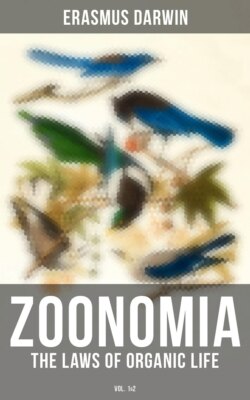Читать книгу Zoonomia - The Laws of Organic Life (Vol. 1&2) - Darwin Erasmus - Страница 11
На сайте Литреса книга снята с продажи.
SECT. V.
OF THE FOUR FACULTIES OR MOTIONS OF THE SENSORIUM.
ОглавлениеTable of Contents
1. Four sensorial powers. 2. Irritation, sensation, volition, association defined. 3. Sensorial motions distinguished from fibrous motions.
1. The spirit of animation has four different modes of action, or in other words the animal sensorium possesses four different faculties, which are occasionally exerted, and cause all the contractions of the fibrous parts of the body. These are the faculty of causing fibrous contractions in consequence of the irritations excited by external bodies, in consequence of the sensations of pleasure or pain, in consequence of volition, and in consequence of the associations of fibrous contractions with other fibrous contractions, which precede or accompany them.
These four faculties of the sensorium during their inactive state are termed irritability, sensibility, voluntarity, and associability; in their active state they are termed as above, irritation, sensation, volition, association.
2. IRRITATION is an exertion or change of some extreme part of the sensorium residing in the muscles or organs of sense, in consequence of the appulses of external bodies.
SENSATION is an exertion or change of the central parts of the sensorium, or of the whole of it, beginning at some of those extreme parts of it, which reside in the muscles or organs of sense.
VOLITION is an exertion or change of the central parts of the sensorium, or of the whole of it, terminating in some of those extreme parts of it, which reside in the muscles or organs of sense.
ASSOCIATION is an exertion or change of some extreme part of the sensorium residing in the muscles or organs of sense, in consequence of some antecedent or attendant fibrous contractions.
3. These four faculties of the animal sensorium may at the time of their exertions be termed motions without impropriety of language; for we cannot pass from a state of insensibility or inaction to a state of sensibility or of exertion without some change of the sensorium, and every change includes motion. We shall therefore sometimes term the above described faculties sensorial motions to distinguish them from fibrous motions; which latter expression includes the motions of the muscles and organs of sense.
The active motions of the fibres, whether those of the muscles or organs of sense, are probably simple contractions; the fibres being again elongated by antagonist muscles, by circulating fluids, or sometimes by elastic ligaments, as in the necks of quadrupeds. The sensorial motions, which constitute the sensations of pleasure or pain, and which constitute volition, and which cause the fibrous contractions in consequence of irritation or of association, are not here supposed to be fluctuations or refluctuations of the spirit of animation; nor are they supposed to be vibrations or revibrations, nor condensations or equilibrations of it; but to be changes or motions of it peculiar to life.
